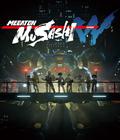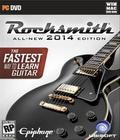While the original Rocksmith was one of the first in the genre to allow players to use real guitars to play the game, it was also hampered by issues. Long load times, a cumbersome interface, and latency issues brought down what was otherwise a strong game that was based on a great technical achievement. Rocksmith 2014 is the sequel, and even its name is geared around the mindset that it's not merely the same game with a few new toys. Instead, Rocksmith 2014 feels like a reboot of the franchise. It took a lot of the criticism of the previous game to heart, so this title comes across as much stronger.
The core idea behind the game has not changed. In Rocksmith 2014, guitarists of any experience level can expect to engage the game, which still features a sliding difficulty scale attached to your game profile. Everyone starts off at the easiest difficulty, and as you play successfully, the game starts throwing more notes at you or begins changing single notes into the actual chords. It is an organic transition that feels similar to the original game, but there are numerous changes.
For starters, the game no longer considers the difficulty level of the entire song but now smartly breaks it up across sections. This makes it possible to have the full note structure presented for an easier part, but the game also knows to scale down a complicated solo or a particularly tricky bridge. This removes the previous complaint of some songs being incredibly simple for a majority of the tune, ramping up the difficulty as you ace every note, and then slaying you with a full-bore crazy solo that you have no hope of learning in that limited time. This difficulty scaling per section now also includes the mastery mode, with a different approach. Rather than notes completely going away for a section, they begin to gradually fade away in the sections where you're doing well, forcing you to learn and remember them. For the sections you haven't mastered, the notes reappear or return from their semi-transparent state. It's a much more organic teaching tool than the song-wide all-or-nothing approach.
The game continues to directly address previous concerns in its new ability to enter the Riff Repeater literally from the middle of a song. If some part of a song is destroying your brain, you can simply hit the Space bar (AKA the biggest, easiest key to hit while wielding a bass guitar) and immediately enter the Riff Repeater mode for that portion. You can adjust tempo, difficulty, and other options and really pick apart and learn that segment. Then, once you feel comfortable, you can exit Riff Repeater and get right back into the song exactly where you left off, with a few seconds of lead-in time to regain your musical bearings. Now, when you get destroyed by a solo you haven't learned, you can immediately learn it, rather than having to play through the song again to try and pick it up as part of the whole.
This cohesion is something that Rocksmith 2014 has tried to apply across the board. The entire game simply flows much better from menu to menu, with faster load times and a better sense of organization. Go into "Learn a Song," and you can pick any song from the list, with all songs unlocked from the get-go. Pick that song, and you can either play it or take a corresponding lesson on it. If the song contains a lot of slides, the game may recommend watching and taking the slide lesson to get acquainted with them. If you've already played the song, these recommendations become personalized, such as, "It seems you had some trouble with the slides in this song. Taking this lesson may help you out."
This teaching mentality is a guiding force behind the game. The whole "play through a series of gigs" motif has been thrown out; instead, the game is much more of a musical sandbox and offers a guiding hand if you want it. The "Rocksmith Recommends" functionality guides you toward the different areas of the game and how to use them, and it does a good job of explaining why. You aren't playing one of the many new Guitarcade minigames as a creative break; you are doing so because each one teaches you a new skill. The system also guides you toward lessons, particular song choices, and other aspects so players who are new to guitars can navigate the sandbox without getting overwhelmed.
One particularly fun new addition is Session mode, in which you can pick your instrument (lead guitar, rhythm guitar, bass guitar) and jam along with an AI-controlled band. You pick the band's instruments, set the note scale and some other options, and then you take the mantle of being the band's leader. You start playing and the AI band plays its instruments while matching your intensity, tempo and volume. The bottom of the screen shows the selected scale of notes, so you can essentially pick any of them and mess around, and it quickly becomes an awesome way to learn how to play in your own environment. The band doesn't react to changes quite as quickly as a human player would, such as changing up tempo or stopping the jam altogether, but it's a blast to rock out in this mode. You can certainly add a second human player to flesh out the jam session.
Overall, multiplayer is handled quite well, and the same Rocksmith cables from the original game work for the new release. You can play together in the learning mode just as you can in single-player, and each player's progress and difficulty carries over into his or her respective single-player "progress." In addition to the previously mentioned multiplayer Session mode, players can also compete or cooperate in scored playing modes. It was in this mode that we noticed the first issue: Backing out from multiplayer mode asked us to unplug one of the Rocksmith cables (since it didn't know which one to use) and then the game locked up. It only happened once, but hopefully, that logic will get polished in an upcoming patch.
As much of an improvement as the game is over the original, Rocksmith 2014 is not without flaws. The PC version is still a bit sensitive, and this time around, it's regarding other programs/drivers in the background. It could have been Skype or Virtual Audio Cable, etc., but in our review machine, the game would load with incredibly slowed, distorted sound unless we nuked a few background processes. The game also has a launch system that is borderline madness in that you launch the game through Steam, but then Uplay grabs it from there. You'd think it would be better to launch the game directly through the Uplay application, but if you try to do that, Uplay tells you to launch the game via Steam. It makes the Uplay integration feel completely needless, though it is at least a completely transparent step once you've saved your Uplay credentials into the app.
Finally, for better or worse, Rocksmith 2014 maintains the same methodology of displaying notes to the player that it had in the previous game. On the one hand, this method is not unlike the format of Rock Band and Guitar Hero, with colored note strings along a horizontal fretboard. However, as a (somewhat) experienced guitarist, this can be viewed as a limitation. While it makes the transition from other games easier, it is obviously not music's natural format. It isn't teaching you how to read guitar music; it's teaching you how to read it in a format that's unique to the game. Thus, while the game does a great job of getting new players familiar with the instrument and mechanically able to play music, it doesn't strive toward equipping players with the knowledge to read guitar tablature and bridge the gap into playing "any" song.
However, one gets the impression that isn't the point. At its core, Rocksmith is a franchise that is very much geared toward weaning players off plastic guitars and on to ones made of wood and metal. Rocksmith 2014 is an excellent evolution on that set of ideals. The game restructuring makes it easier to play while retaining its sense of guidance and learning. The multiplayer has seen a little love, but the big new feature has to be Session mode in its ability to let players be at the forefront of a respectably cohesive band that follows your lead. It supports the ability to import songs from the original game, so you should pick up Rocksmith 2014 and leave the original game behind. It's easily worth the price thanks to its new features, and new players will find it to be a far better entry point.
Score: 8.8/10
More articles about Rocksmith 2014 Edition











 With a completely redesigned interface and all-new features, Rocksmith 2014 Edition is tailored to better teach the key elements of guitar playing, and to make learning faster and more fun than any other method.
With a completely redesigned interface and all-new features, Rocksmith 2014 Edition is tailored to better teach the key elements of guitar playing, and to make learning faster and more fun than any other method.




























